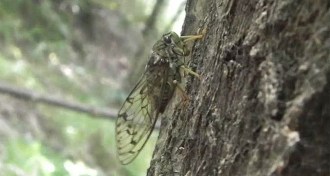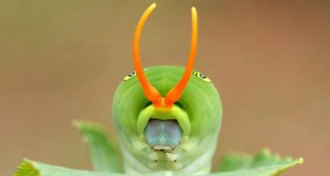Science Ticker
A roundup of research and breaking news
Sign up for our newsletter
We summarize the week's scientific breakthroughs every Thursday.
-
 Health & Medicine
Health & MedicineCDC panel gives thumbs up to vaccine against nine HPV types
A federal vaccine advisory committee voted February 26 to recommend use of an expanded version of the human papillomavirus shot marketed as Gardasil.
By Nathan Seppa -
 Planetary Science
Planetary ScienceMysterious bright spot on Ceres has a partner
A new image from the Dawn spacecraft finds two bright patches within a basin, possibly caused by an ice volcano.
-
 Animals
AnimalsSome cicadas drum up a beat with the help of their wings
By using their wings as drumsticks, so-called “mute” cicadas can make themselves heard.
-
 Computing
ComputingArtificial intelligence conquers Space Invaders, Pong, Q*bert
With a single algorithm, a computer can learn dozens of classic video games, researchers from Google DeepMind in London report.
-
 Health & Medicine
Health & MedicineStem cells from wisdom teeth could help repair corneas
A study points to a potential new treatment for corneal blindness: Stem cells extracted from pulp from pulled wisdom teeth.
-
 Chemistry
ChemistryBrute-force chemistry study retracted
The journal Science has retracted a notable 2011 chemistry study in which authors reported a brawny method to break sturdy chemical structures.
By Beth Mole -
 Planetary Science
Planetary ScienceNew Horizons spies two of Pluto’s moons
Nix and Hydra come into view on the 85th anniversary of Pluto’s discovery.
-
 Planetary Science
Planetary ScienceDwarf planet Ceres comes into view
New images from the Dawn spacecraft reveal a landscape of craters and mysterious bright patches on the dwarf planet Ceres.
-
 Astronomy
AstronomyPair of stars buzzed the solar system 70,000 years ago
Astronomers discover a binary system that made the closest known flyby of the sun.
-
 Life
LifeTo deal with sexual conflict, female bedbugs get flexible
Female bed bugs evolved an elastic underbelly to tolerate violent mating, a new study suggests.
-
 Oceans
OceansMillions of tons of plastic end up in oceans each year
A new estimate quantifies how much plastic makes its way into the world’s oceans.
By Beth Mole -
 Animals
AnimalsTiger swallowtail genome gives clues to insect’s stinky defense
Clues within the genetic code of the Eastern tiger swallowtail butterfly (Papilio glaucus) explain how it developed a smelly defense against predators.